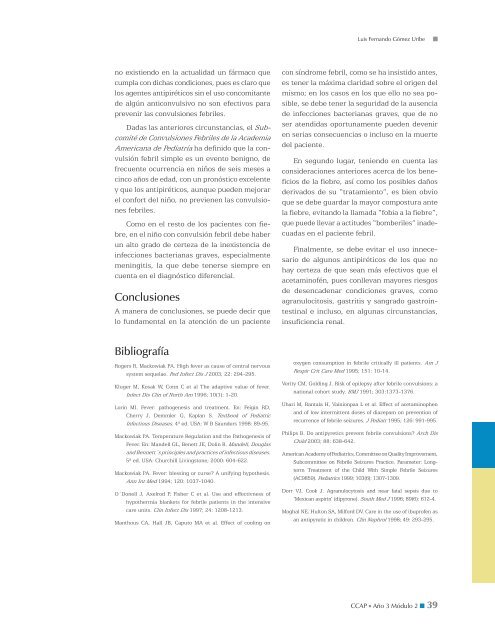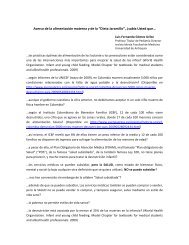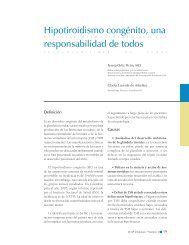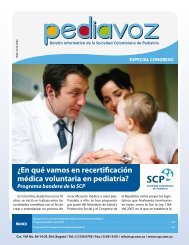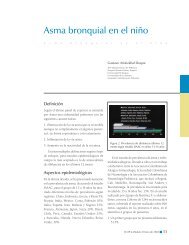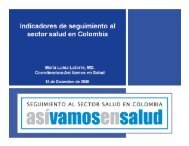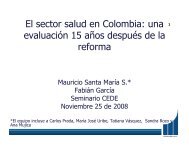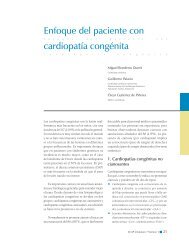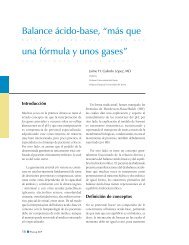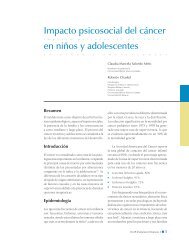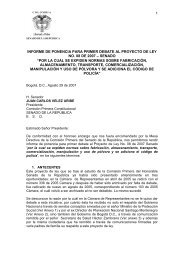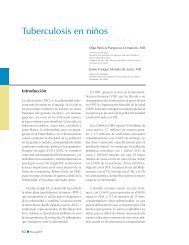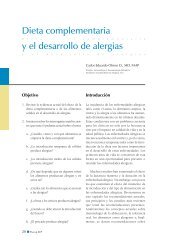La fiebre: ¿Fuego de vida o castigo divino
La fiebre: ¿Fuego de vida o castigo divino
La fiebre: ¿Fuego de vida o castigo divino
Create successful ePaper yourself
Turn your PDF publications into a flip-book with our unique Google optimized e-Paper software.
Luis Fernando Gómez Uribe<br />
no existiendo en la actualidad un fármaco que<br />
cumpla con dichas condiciones, pues es claro que<br />
los agentes antipiréticos sin el uso concomitante<br />
<strong>de</strong> algún anticonvulsivo no son efectivos para<br />
prevenir las convulsiones febriles.<br />
Dadas las anteriores circunstancias, el Subcomité<br />
<strong>de</strong> Convulsiones Febriles <strong>de</strong> la Aca<strong>de</strong>mia<br />
Americana <strong>de</strong> Pediatría ha <strong>de</strong>finido que la convulsión<br />
febril simple es un evento benigno, <strong>de</strong><br />
frecuente ocurrencia en niños <strong>de</strong> seis meses a<br />
cinco años <strong>de</strong> edad, con un pronóstico excelente<br />
y que los antipiréticos, aunque pue<strong>de</strong>n mejorar<br />
el confort <strong>de</strong>l niño, no previenen las convulsiones<br />
febriles.<br />
Como en el resto <strong>de</strong> los pacientes con <strong>fiebre</strong>,<br />
en el niño con convulsión febril <strong>de</strong>be haber<br />
un alto grado <strong>de</strong> certeza <strong>de</strong> la inexistencia <strong>de</strong><br />
infecciones bacterianas graves, especialmente<br />
meningitis, la que <strong>de</strong>be tenerse siempre en<br />
cuenta en el diagnóstico diferencial.<br />
Conclusiones<br />
A manera <strong>de</strong> conclusiones, se pue<strong>de</strong> <strong>de</strong>cir que<br />
lo fundamental en la atención <strong>de</strong> un paciente<br />
con síndrome febril, como se ha insistido antes,<br />
es tener la máxima claridad sobre el origen <strong>de</strong>l<br />
mismo; en los casos en los que ello no sea posible,<br />
se <strong>de</strong>be tener la seguridad <strong>de</strong> la ausencia<br />
<strong>de</strong> infecciones bacterianas graves, que <strong>de</strong> no<br />
ser atendidas oportunamente pue<strong>de</strong>n <strong>de</strong>venir<br />
en serias consecuencias o incluso en la muerte<br />
<strong>de</strong>l paciente.<br />
En segundo lugar, teniendo en cuenta las<br />
consi<strong>de</strong>raciones anteriores acerca <strong>de</strong> los beneficios<br />
<strong>de</strong> la <strong>fiebre</strong>, así como los posibles daños<br />
<strong>de</strong>rivados <strong>de</strong> su “tratamiento”, es bien obvio<br />
que se <strong>de</strong>be guardar la mayor compostura ante<br />
la <strong>fiebre</strong>, evitando la llamada “fobia a la <strong>fiebre</strong>”,<br />
que pue<strong>de</strong> llevar a actitu<strong>de</strong>s “bomberiles” ina<strong>de</strong>cuadas<br />
en el paciente febril.<br />
Finalmente, se <strong>de</strong>be evitar el uso innecesario<br />
<strong>de</strong> algunos antipiréticos <strong>de</strong> los que no<br />
hay certeza <strong>de</strong> que sean más efectivos que el<br />
acetaminofén, pues conllevan mayores riesgos<br />
<strong>de</strong> <strong>de</strong>senca<strong>de</strong>nar condiciones graves, como<br />
agranulocitosis, gastritis y sangrado gastrointestinal<br />
e incluso, en algunas circunstancias,<br />
insuficiencia renal.<br />
Bibliografía<br />
Rogers R, Mackowiak PA. High fever as cause of central nervous<br />
system sequelae. Ped Infect Dis J 2003; 22: 294-295.<br />
Kluger M, Kosak W, Conn C et al The adaptive value of fever.<br />
Infect Dis Clin of North Am 1996; 10(1): 1-20.<br />
Lorin MI. Fever: pathogenesis and treatment. En: Feigin RD,<br />
Cherry J, Demmler G, Kaplan S. Textbook of Pediatric<br />
Infectious Diseases. 4ª ed. USA: W B Saun<strong>de</strong>rs 1998: 89-95.<br />
Mackowiak PA. Temperature Regulation and the Pathogenesis of<br />
Fever. En: Man<strong>de</strong>ll GL, Benett JE, Dolin R. Man<strong>de</strong>ll, Douglas<br />
and Bennett´s principles and practices of infectious diseases.<br />
5ª ed. USA: Churchill Livingstone; 2000: 604-622.<br />
Mackowiak PA. Fever: blessing or curse A unifying hypothesis.<br />
Ann Int Med 1994; 120: 1037-1040.<br />
O´Donell J, Axelrod P, Fisher C et al. Use and effectivness of<br />
hypothermia blankets for febrile patients in the intensive<br />
care units. Clin Infect Dis 1997; 24: 1208-1213.<br />
Manthous CA, Hall JB, Caputo MA et al. Effect of cooling on<br />
oxygen consumption in febrile critically ill patients. Am J<br />
Respir Crit Care Med 1995; 151: 10-14.<br />
Verity CM, Golding J. Risk of epilepsy after febrile convulsions: a<br />
national cohort study. BMJ 1991; 303:1373-1376.<br />
Uhari M, Rantala H, Vainionpaa L et al. Effect of acetaminophen<br />
and of low intermittent doses of diazepam on prevention of<br />
recurrence of febrile seizures. J Pediatr 1995; 126: 991-995.<br />
Philips B. Do antipyretics prevent febrile convulsions Arch Dis<br />
Child 2003; 88: 638-642.<br />
American Aca<strong>de</strong>my of Pediatrics, Committee on Quality Improvement,<br />
Subcommittee on Febrile Seizures Practice. Parameter: Longterm<br />
Treatment of the Child With Simple Febrile Seizures<br />
(AC9859). Pediatrics 1999; 103(6): 1307-1309.<br />
Dorr VJ, Cook J. Agranulocytosis and near fatal sepsis due to<br />
‘Mexican aspirin’ (dipyrone). South Med J 1996; 89(6): 612-4.<br />
Moghal NE, Hulton SA, Milford DV. Care in the use of ibuprofen as<br />
an antipyretic in children. Clin Nephrol 1998; 49: 293-295.<br />
CCAP Año 3 Módulo 2 39<br />
la <strong>fiebre</strong>.indd 39<br />
25/06/2004 09:45:33 a.m.


